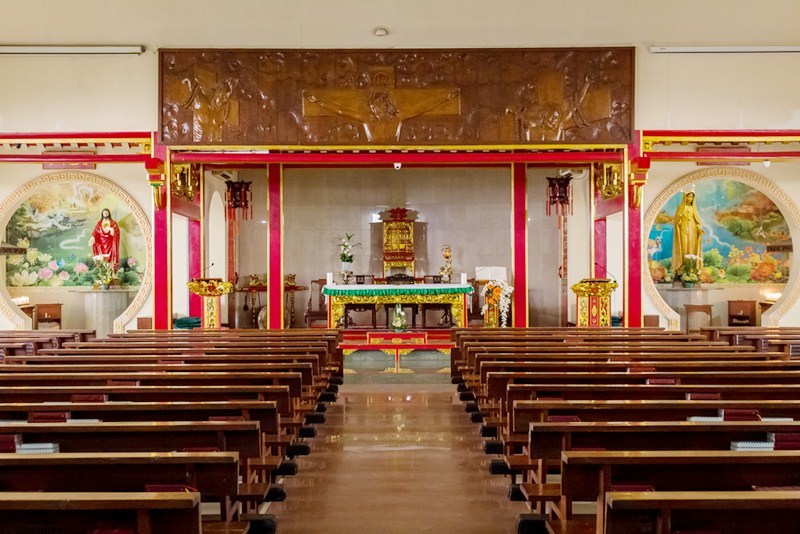The most popular Chinese-Indonesian heritage sites in Jakarta are Chinatown in Petak Sembilan, Glodok or Pasar Baru. Chinese migration to Indonesia began in the 17th century, when the East Indies trade partnership (VOC) succeeded in inviting the Chinese from the mainland to immigrate to various islands in Indonesia.

There are many places in Jakarta which carry a strong Chinese influence in architecture and culture. Here are a few of them
The Church of Santa Maria de Fatima
The Church of Santa Maria de Fatima is a Catholic house of worship. Located at Jalan Kemenangan III no 47, Glodok, the Church is designed in a Chinese manner. It was named a Cultural Heritage site in 1972. The architecture is int the original Fukien style from Southern China. Originally built as house, it was purchased by a priest in 1950 and converted to a Church.
Souw Siaw House
This classic building is the former house of the Souw merchant family which built it in 1816. Brothers Souw Siauw Tjong and Souw Siauw Keng were traders in the area. Souw Siauw Tjong was believed to be one of the richest people in Batavia at that time. Souw helped establish schools for the children of the local community. The Souw family's home continues to be maintained in all its original glory.
Lay An Tong Drugstore
Lay An Tong, is an old building that is well preserved despite not being a drug store at present. The shape of the house is the same as are the floors, walls and roof. Indonesia Heritage Society considered Lay An Tong as a most popular and biggest drugstore. Physical evidence of big buildings, large area, and strong iron bars are one of the original establishments that reflects East Asian style.

Vihara Dharma Bhakti
The Vihara Dharma Bhakti complex was erected in 1650 under the order of Luitenant der Chinezen Kwee Hoen. The temple was burned to the ground during the massacre of the ethnic Chinese communities in 1740. Vihara Dharma Bhakti is the centre of Chinese-related festivities in Jakarta. Among the most notable celebrations held in the temple was the Hungry Ghost Festival (or Cioko in Hokkien) held in the temple's courtyard, and the Lantern Festival (Cap go meh). During the colonial period, a Peranakan Chinese opera was performed yearly every Vesak, accompanied by the Batavian kroncong music and enlivened with traditional games. These days, It is still functions as a place of worship.
Candra Naya House
The home of the Chinese Major Khouw Kim An is now a Candra Naya building is a cultural preservation sites in the Jakarta. Candra Naya was built in 1807 or earlier in the late 18th century, originally a private residence of the Khouw family of Tamboen. In this marble-floored building, there are various rooms such as family rooms, bedrooms, service rooms, guest lounge and prayer rooms along with the altar in the middle of the house. The main entrance is decorated with four Chinese characters. In the main room, four carvings of lions were seen adorning the beams of horses. It’s a house of Chinese conglomerate back in the day.
In February 2012, the main buildings of Candra Naya were reassembled after being temporarily dismantled to make way for the construction of Green Central City. The ancillary buildings and the gazebo were also rebuilt after being completely demolished. The rear private building was never rebuilt.
SMUN 19
SMUN 19 (High School) is one of historic buildings established as a Modern Chinese organisation. This school is the first modern private school in the Dutch East Indies. The students are both Chinese and local. They learn algebra, arithmetic, customs, and Chinese culture. It’s a school signpost written in Chinese script “Tiong Hoa Hwee Koan”, the first modern private school in Indonesia built in Batavia. The school now is SMUN 19 (senior high school) or in Chinese 19 is Cap Kau, located in Kota, West Jakarta. SMUN 19 was formed by Tiong Hoa Hwe Koan, the first organisation in Indonesia for those of Chinese descent who settled in Batavia.

Toko Kompak at Pasar Baru
Toko Kompak is a historic landmark in Pasar Baru, Jakarta. It was the residence of Tio Tek Ho, Majoor der Chinezen (1896-1908), who was the penultimate head of the Chinese community during the colonial era. The building was probably built in the first half of the 19th century in a combination of Chinese, European and native Indonesian architectural style.







